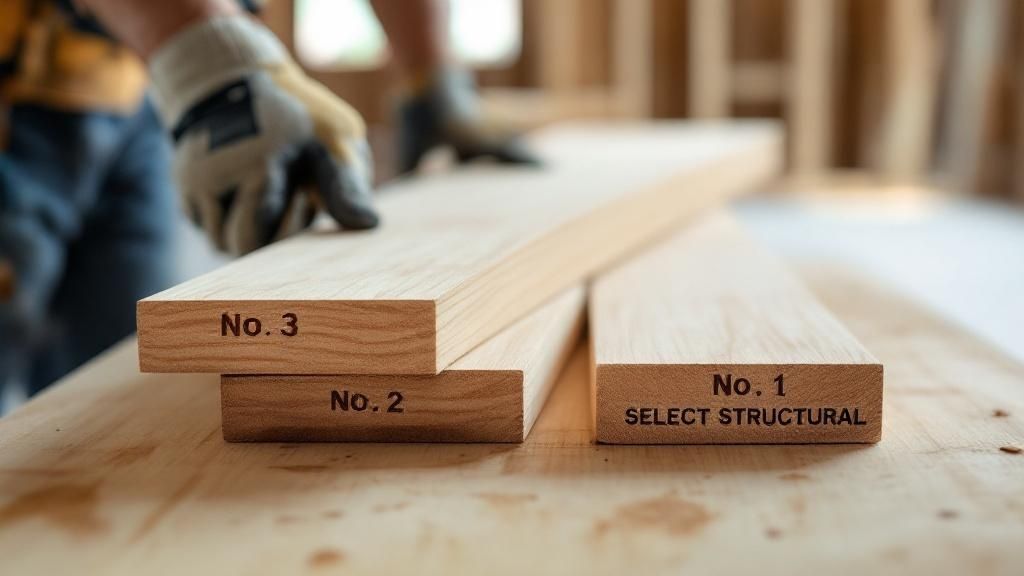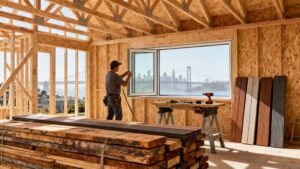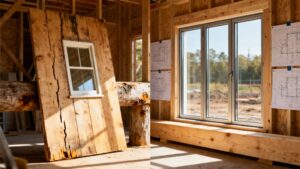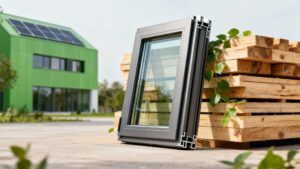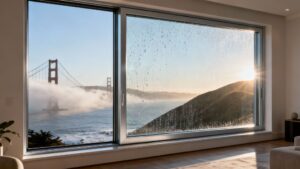When you pick up a piece of framing lumber, you're holding a product with a built-in performance guarantee. Lumber grades are the standardized language that tells us about a piece of wood's structural strength and overall quality. This system is based on its natural characteristics like knots and grain.
It’s how we ensure the right board ends up in the right place, whether it's for a simple wall stud or a critical support beam in a Bay Area home.
Why Framing Lumber Grades Matter for Bay Area Construction
For builders, contractors, and architects in the Bay Area, understanding lumber grades is about safety, budgets, and building structures that last. This system turns a natural, variable material like wood into a predictable and reliable building component. Think of it as the DNA of your structure, dictating its performance for years to come.
Using the right grade is essential for meeting California's strict building codes, which is a make-or-break for passing inspections in places like Berkeley and Oakland. Making the right choice means you avoid both dangerous under-engineering and wasteful, budget-busting over-engineering.
The Foundation of Structural Integrity
The idea behind grading lumber is straightforward: a board's strength is directly tied to its natural flaws and features. A grading system gives us a dependable way to evaluate these characteristics and assign a performance value to the wood.
- Knots: The size, type, and location of knots can seriously impact a board's ability to handle tension and bending forces.
- Slope of Grain: Wood is strongest when force is applied parallel to the grain. A steep grain angle can weaken it considerably.
- Wane: This is bark or missing wood on the edge or corner of a board, which reduces its structural capacity.
This system is kept in check by organizations like the American Lumber Standard Committee (ALSC). They ensure that a #2 grade Douglas Fir from an Oregon mill has the same structural rating as one from a Washington mill. That consistency is the bedrock of modern construction.
The global lumber industry was valued at roughly USD 337.8 billion in 2023 and is only expected to grow, fueled by construction projects that rely on framing lumber. This knowledge directly impacts your bottom line and your project's longevity. It's also important to see how these grades fit into the bigger picture of building codes and regulations; for example, staying informed on updates like the new Scottish building regulations can provide valuable perspective.
Common Framing Lumber Grades Explained
Let's move from the grading rules on paper to the stacks of lumber you’ll find on a Bay Area job site. When you walk into a quality lumberyard, you're looking at a system of grades that follows a "good, better, best" approach. Getting a feel for this system is how you build safely, keep your project on budget, and get the job done right.
This visual gives you a quick overview of how the main structural grades are categorized.
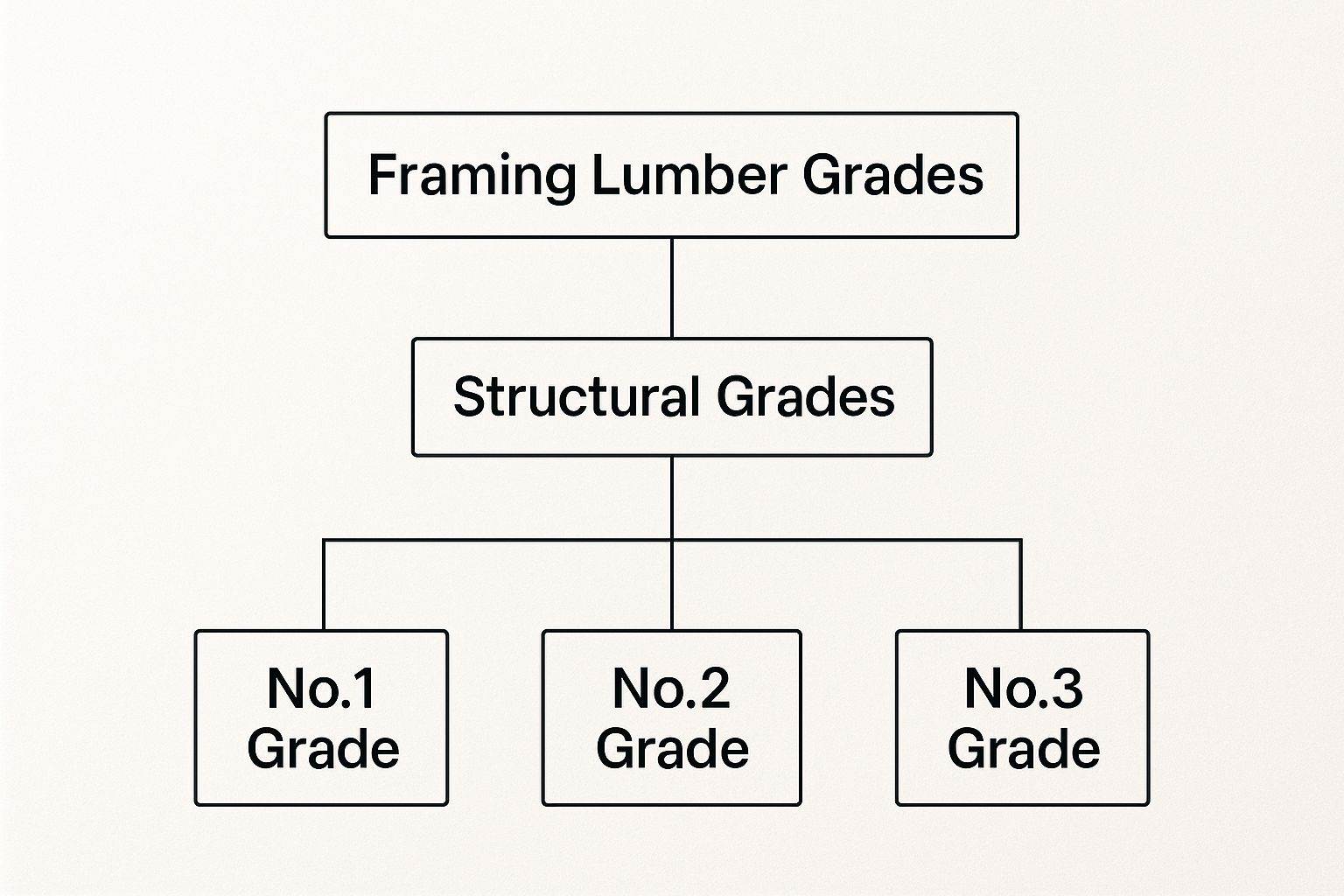
As you can see, each grade comes with a different set of performance specs based on what grading agencies allow in terms of natural characteristics.
To make this even clearer, here’s a quick reference table that breaks down what you’ll see and where to use it.
Common Framing Lumber Grades at a Glance
| Lumber Grade | Key Visual Characteristics | Best Use Cases | Relative Cost |
|---|---|---|---|
| #3 & Utility | More frequent and larger knots, some splits, noticeable wane. | Temporary work: concrete forms, bracing, crating, scaffold planks. | Lowest |
| #2 | Moderate knots and wane, but limited in size. The industry standard. | The go-to for most framing: studs, joists, rafters. | Moderate |
| #1 | Smaller, tighter knots and straighter grain. A cleaner appearance. | Exposed beams, applications needing longer spans or a better look. | Higher |
| Select Structural | Very few, small knots. The cleanest and straightest grain. | Engineered applications where maximum strength is critical. | Highest |
This table gives you the basics, but let’s dig into the specifics of what makes each grade tick.
Utility and #3 Grade Lumber
At the most economical end of the spectrum are Utility and #3 grade lumber. These boards have more character—more knots, some splits, and other natural blemishes. Because of this, their strength isn't reliably rated for anything that has to carry a structural load.
But that doesn't mean they aren't useful. They are a fantastic, budget-friendly option for behind-the-scenes work where top-tier strength isn't the point.
- Temporary bracing to hold up walls during construction
- Building concrete forms
- Scaffold planking
- Crates and other shipping materials
Using these grades for the right task is just smart building. You save on material costs without compromising the structural integrity of the project.
#2 Grade: The Workhorse of Construction
Now we get to the undisputed champion of residential framing: #2 grade lumber. If you've framed a house in the Bay Area, you've worked with #2. It hits the sweet spot between reliable strength, consistent quality, and a price that makes sense for large-scale use.
In fact, it’s estimated that #2 grade lumber makes up 60-70% of all framing material used in new home construction in the U.S.
Visually, you'll see some knots and wane on a #2 board, but grading rules are strict about their size and placement. This ensures every piece meets its engineered strength values. It’s the go-to choice for almost every part of a standard frame:
- Wall studs
- Floor joists
- Rafters and roof trusses
- General framing needs
For the vast majority of projects, #2 grade lumber has all the strength you need to meet and even exceed building code requirements.
#1 Grade: For Higher Strength and Appearance
When you need something extra, whether it's more muscle or a cleaner look, you step up to #1 grade. This lumber has smaller, fewer knots and a straighter grain than its #2 counterpart. The result is a board that's both stronger and better-looking.
You’ll see contractors spec #1 grade for things like:
- Exposed rafters or beams in a vaulted ceiling
- Structural posts that are also a design feature
- Joists or rafters that need to span a longer distance than #2 can handle
It costs more, but when aesthetics or specific load requirements demand it, that extra investment is well worth it. You can find a solid selection of quality lumber in the East Bay at a supplier who understands these demands.
Select Structural: The Premium Choice
At the top of the pile is Select Structural (SS). This is the "best" of the best—the strongest, cleanest dimension lumber you can get. Each piece is inspected to guarantee it has the fewest and smallest possible defects, delivering maximum strength and density.
You would never frame an entire house with Select Structural; the cost would be astronomical. It’s reserved for critical components where failure is not an option—a crucial factor in seismically active areas like San Francisco. Its use is almost always dictated by a set of engineered plans.
How to Read a Lumber Grade Stamp
Every piece of structural lumber has a story to tell, and it’s all written in the grade stamp. For contractors on a busy Berkeley job site or an architect finalizing plans in Oakland, understanding this stamp isn't just good practice—it's essential.
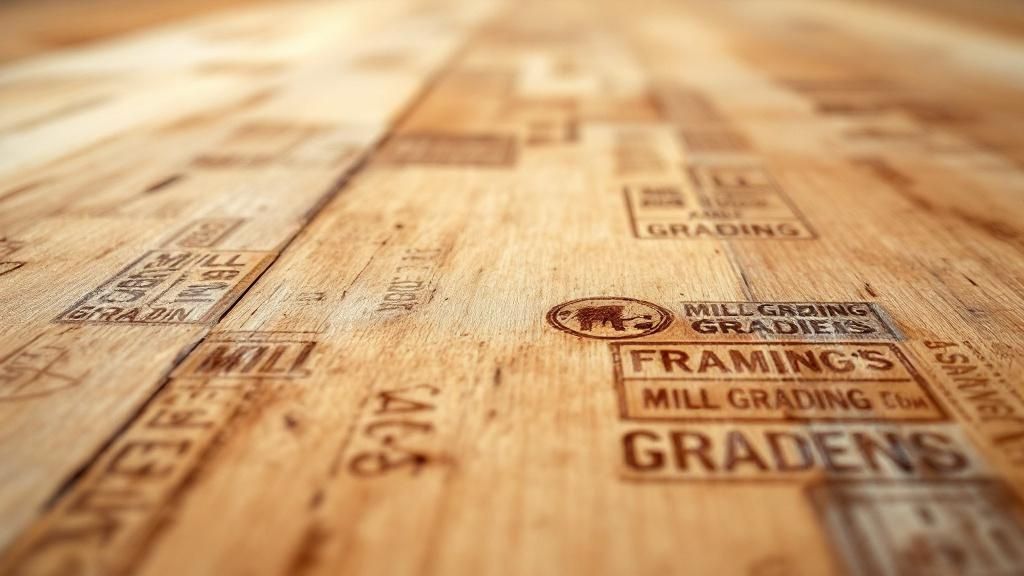
This stamp is your field guide, right there on the board. It’s the ultimate proof that you have the right material for the job, helping you sidestep costly mistakes and ensure your structure is up to code. Let’s break down the five key pieces of information you'll find.
The Five Elements of a Grade Stamp
Once you know what to look for, decoding a grade stamp is surprisingly straightforward. This information is your guarantee of performance.
-
Grading Agency Mark: This is the official logo of the agency that inspected and certified the lumber, like the Western Wood Products Association (WWPA). It’s your assurance that the grade is accurate and supervised by the American Lumber Standard Committee (ALSC).
-
Mill Number: Every mill has a unique number. This tells you exactly where the lumber was produced, providing complete traceability.
-
The Grade: This is the most critical part for day-to-day work. It clearly states the framing lumber grade—#2, #1, or STUD, for example.
-
Species Mark: This abbreviation tells you the type of wood. You'll see codes like DOUG FIR-L (for the Douglas Fir-Larch group) or S-P-F (for Spruce-Pine-Fir).
-
Moisture Content: This reveals how dry the wood was when it was graded. S-GRN means the lumber was surfaced "green" with over 19% moisture. KD19 or S-DRY means it was kiln-dried to 19% or less.
For builders in the Bay Area, paying attention to moisture content is critical. Using kiln-dried (KD) lumber for interior framing prevents the shrinkage, warping, and nail pops that can occur as green lumber dries in our diverse microclimates.
By understanding these five elements, you can instantly confirm that the lumber delivered to your job site is what was specified. It’s a quick check that can save you from massive headaches and failed inspections. For more insights on sourcing materials that last, check out our guide on durable materials for contractors.
Choosing Your Lumber: SPF vs. Douglas Fir
When you're sorting through framing lumber grades, the species of wood is as important as the grade stamp. For most of us building in the Bay Area, the choice almost always boils down to two major players: Spruce-Pine-Fir (SPF) and Douglas Fir-Larch (DF-L). Knowing the real-world differences between them is crucial for building a solid, safe structure.
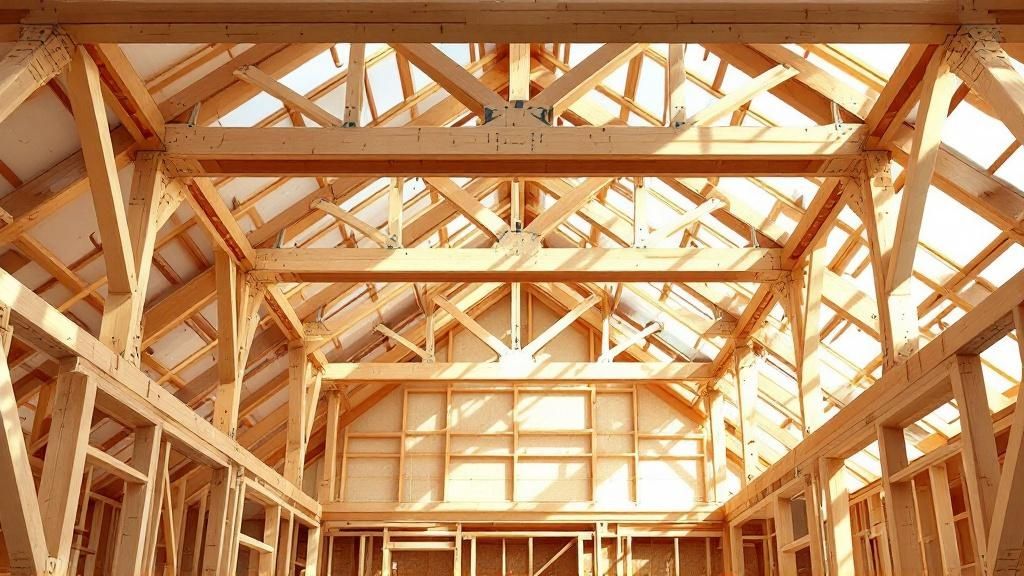
Think of it like picking a vehicle. SPF is your reliable work van—lightweight, easy to handle, and perfect for most daily tasks. Douglas Fir is the heavy-duty truck you bring in when you need raw power and toughness.
Understanding Spruce-Pine-Fir (SPF)
Spruce-Pine-Fir, or SPF, is a mix of coniferous woods that share similar characteristics. They're known for being lightweight, having a straight grain, and being a breeze to cut and nail. This workability is a big reason framing crews love it; it helps them move fast.
Because it's not as dense as Douglas Fir, SPF is also typically easier on the wallet. This makes it a smart, economical pick for standard applications.
- Standard Wall Framing: For most interior and non-load-bearing walls, SPF is plenty strong.
- Roof Trusses: Its high strength-to-weight ratio makes it the go-to for engineered roof trusses.
- General Utility: It’s great for blocking, cripple walls, and other common framing components.
The main trade-off? SPF has lower bending strength and nail-holding power compared to denser woods.
The Strength of Douglas Fir-Larch (DF-L)
When structural plans call for serious muscle, Douglas Fir (often grouped with Larch as DF-L) is the undisputed champ on the West Coast. Sourced mainly from the Pacific Northwest, this wood is significantly denser, harder, and stronger than SPF. That built-in strength gives it superior performance in any application involving heavy loads or long spans.
This species really shines in the tough spots:
- Floor and Ceiling Joists: Its stiffness prevents the bouncy or sagging floors you can get when using weaker materials over long spans.
- Rafters and Beams: It can handle heavy roof loads, including in areas expecting heavy rain or the added weight from solar panels.
- Headers and Girders: For big openings over doors and windows, Douglas Fir provides the strength needed to carry the load from above.
Making the Right Choice for Bay Area Projects
Here in the Bay Area, the choice between SPF and Douglas Fir often comes down to seismic concerns. California's building codes are some of the toughest in the country for a reason. The superior strength and stiffness of Douglas Fir make it the preferred material for many structural elements in seismic retrofits and new construction in Berkeley, Oakland, and San Francisco.
Its excellent nail and fastener holding power creates a more robust connection, which is absolutely critical for a resilient structural frame. For expert advice on getting the right materials, you can check out the wide range of building material supplies in San Francisco and throughout the Bay Area.
Matching Lumber to Your Bay Area Project
Knowing the difference between lumber grades on paper is one thing; knowing which board to grab for which part of the job is another. This is your field guide for making smart lumber choices on your next Bay Area build. It's all about balancing what the code demands, what the structure needs, and what your wallet can handle.
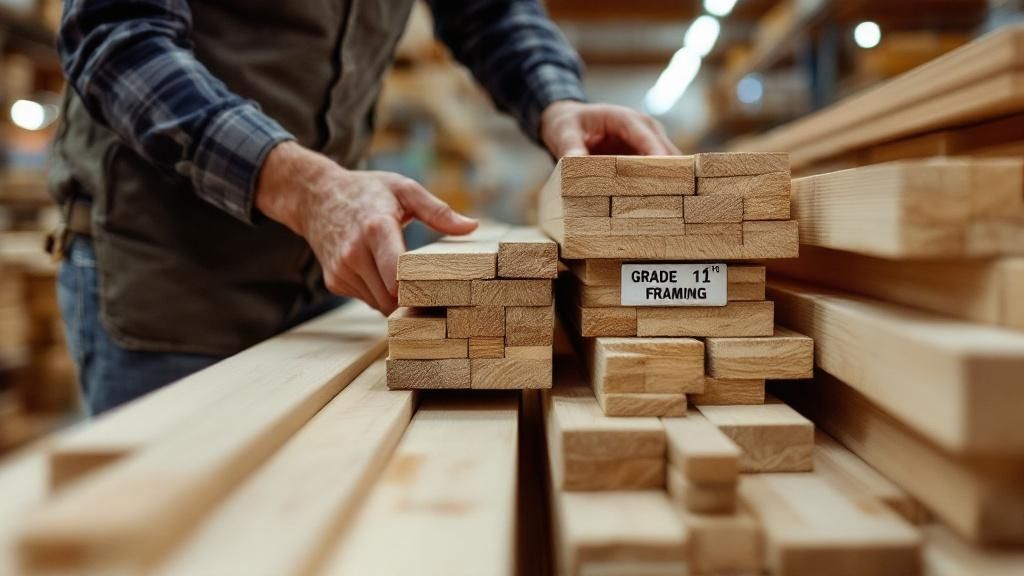
In 2023, the U.S. produced around 33.8 billion board feet of framing lumber, with wood framing used in about 90% of new single-family homes, according to industry reports. That’s a lot of lumber, and making the right call on every stick matters. If you want to dive deeper into the market numbers, you can explore detailed production insights on businessresearchinsights.com.
General Framing: Your Go-To for Interior Walls
For the vast majority of interior walls, #2 grade SPF (Spruce-Pine-Fir) is the undisputed workhorse. It gives you all the structural integrity the code requires, but it's also lightweight and easy on the budget. Sticking with #2 SPF for standard walls is just smart business.
High-Load Applications: Headers, Joists, and Rafters
When you get to the parts doing the heavy lifting, the game changes. This is where a species like #1 grade Douglas Fir earns its keep. For any part of the frame that has to carry a serious load over a span, you need that superior strength.
Think about these key spots:
- Headers: Spanning a wide opening for a garage door? A #1 Doug Fir header has the muscle to carry the roof and floor loads above without sagging.
- Floor Joists: Nobody wants a bouncy floor. Using #1 Doug Fir for joists creates that solid, stable feel underfoot.
- Rafters: For beefy roof systems, particularly those with long runs, #1 grade lumber gives you a much bigger margin of safety.
Bay Area Specifics: Moisture and Seismic Demands
Building in Berkeley, Oakland, or anywhere else around the Bay means you’re dealing with unique challenges. Our coastal moisture and seismic risks directly impact your lumber choices.
1. Moisture and Sill Plates
The California Building Code is clear: any wood touching a concrete foundation must be pressure-treated. Standard, untreated lumber will wick moisture from the concrete, leading to rot and termites. Always use pressure-treated Douglas Fir for your sill plates.
2. Seismic Retrofitting
Earthquakes demand a structure that can flex without failing. When doing a seismic retrofit, engineers almost always specify higher-grade lumber to strengthen key connections. This often means using #1 or Select Structural Douglas Fir for new shear walls, cripple wall bracing, and bolting the frame to the foundation. The density and fastener-holding power of Douglas Fir are essential here.
Ultimately, every choice you make affects the safety, durability, and cost of your project. For one-on-one advice on framing lumber grades, check out our lumber and building materials sales.
Your Questions About Framing Lumber Answered
A few key questions about framing lumber grades always seem to pop up on the job. Getting a clear, straight answer can be the difference between a project that runs smoothly and one that hits a costly snag. Here are the most common questions we hear from pros in the Bay Area.
Can I Use a Lower Lumber Grade to Save Money?
Yes, but only where it makes sense. Using a lower-cost grade like #3 for non-structural applications like temporary bracing is a smart way to manage your budget. However, you can't substitute a lower grade for a specified structural part, as it creates a serious risk of structural failure and will fail a building inspection.
What Is MSR Lumber and When Is It Necessary?
MSR stands for Machine Stress Rated lumber. Unlike visually graded lumber, every piece of MSR lumber is machine-tested to verify its specific strength and stiffness. You'll typically see MSR lumber specified by engineers for critical components like roof trusses or engineered beams where performance must be guaranteed.
Why Does Moisture Content on the Grade Stamp Matter?
Moisture content is critical for long-term performance in the Bay Area’s diverse microclimates. Wood stamped S-GRN ("surfaced green") can warp and shrink as it dries, causing drywall cracks and nail pops. Lumber stamped KD19 or S-DRY has been kiln-dried, making it far more stable and the professional best practice for interior framing.
Is It Okay If My #2 Grade Lumber Has Large Knots?
Yes, it is perfectly normal for #2 grade lumber to have knots. The grading agencies have very specific rules about the size and location of knots allowed, and those allowable "defects" are already factored into the wood's official structural rating. The board still meets the minimum strength requirements to be stamped and sold as #2 grade.
Do I Need Pressure-Treated Lumber for All Framing?
Absolutely not; it would be expensive and unnecessary. California building codes require pressure-treated (PT) lumber only where wood is in direct contact with concrete (like sill plates) or exposed to weather. For all dry, interior framing, standard kiln-dried lumber is the correct and more economical choice.
Choosing the right materials often involves asking the right questions, a principle that applies to more than just lumber. For instance, if you're selecting fixtures, we cover many common questions in our guide with answers for your questions about doors.
At Truitt & White, we believe that empowering our clients with knowledge helps them build better. Whether you're framing a custom home in Berkeley or remodeling a classic in Oakland, getting the right materials starts with getting the right information. If you have more questions or need expert advice on the best framing lumber grades for your project, our team is here to help.
Visit our Berkeley showroom for expert advice.


